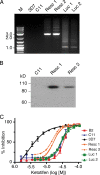A class of tricyclic compounds blocking malaria parasite oocyst development and transmission
- PMID: 23129054
- PMCID: PMC3535893
- DOI: 10.1128/AAC.00920-12
A class of tricyclic compounds blocking malaria parasite oocyst development and transmission
Abstract
Malaria is a deadly infectious disease in many tropical and subtropical countries. Previous efforts to eradicate malaria have failed, largely due to the emergence of drug-resistant parasites, insecticide-resistant mosquitoes and, in particular, the lack of drugs or vaccines to block parasite transmission. ATP-binding cassette (ABC) transporters are known to play a role in drug transport, metabolism, and resistance in many organisms, including malaria parasites. To investigate whether a Plasmodium falciparum ABC transporter (Pf14_0244 or PfABCG2) modulates parasite susceptibility to chemical compounds or plays a role in drug resistance, we disrupted the gene encoding PfABCG2, screened the recombinant and the wild-type 3D7 parasites against a library containing 2,816 drugs approved for human or animal use, and identified an antihistamine (ketotifen) that became less active against the PfABCG2-disrupted parasite in culture. In addition to some activity against asexual stages and gametocytes, ketotifen was highly potent in blocking oocyst development of P. falciparum and the rodent parasite Plasmodium yoelii in mosquitoes. Tests of structurally related tricyclic compounds identified additional compounds with similar activities in inhibiting transmission. Additionally, ketotifen appeared to have some activity against relapse of Plasmodium cynomolgi infection in rhesus monkeys. Further clinical evaluation of ketotifen and related compounds, including synthetic new derivatives, in blocking malaria transmission may provide new weapons for the current effort of malaria eradication.
Figures




Similar articles
-
A New Thienopyrimidinone Chemotype Shows Multistage Activity against Plasmodium falciparum, Including Artemisinin-Resistant Parasites.Microbiol Spectr. 2021 Oct 31;9(2):e0027421. doi: 10.1128/Spectrum.00274-21. Epub 2021 Sep 29. Microbiol Spectr. 2021. PMID: 34724729 Free PMC article.
-
The activities of current antimalarial drugs on the life cycle stages of Plasmodium: a comparative study with human and rodent parasites.PLoS Med. 2012 Feb;9(2):e1001169. doi: 10.1371/journal.pmed.1001169. Epub 2012 Feb 21. PLoS Med. 2012. PMID: 22363211 Free PMC article.
-
Differential activity of methylene blue against erythrocytic and hepatic stages of Plasmodium.Malar J. 2018 Apr 3;17(1):143. doi: 10.1186/s12936-018-2300-y. Malar J. 2018. PMID: 29615050 Free PMC article.
-
Strategic use of antimalarial drugs that block falciparum malaria parasite transmission to mosquitoes to achieve local malaria elimination.Parasitol Res. 2014 Oct;113(10):3535-46. doi: 10.1007/s00436-014-4091-6. Epub 2014 Sep 4. Parasitol Res. 2014. PMID: 25185662 Review.
-
Transmission-blocking drugs for malaria elimination.Trends Parasitol. 2022 May;38(5):390-403. doi: 10.1016/j.pt.2022.01.011. Epub 2022 Feb 19. Trends Parasitol. 2022. PMID: 35190283 Review.
Cited by
-
Monitoring the Prevalence of Leucocytozoon sabrazesi in Southern China and Testing Tricyclic Compounds against Gametocytes.PLoS One. 2016 Aug 29;11(8):e0161869. doi: 10.1371/journal.pone.0161869. eCollection 2016. PLoS One. 2016. PMID: 27571513 Free PMC article.
-
Malaria biology and disease pathogenesis: insights for new treatments.Nat Med. 2013 Feb;19(2):156-67. doi: 10.1038/nm.3073. Epub 2013 Feb 6. Nat Med. 2013. PMID: 23389616 Free PMC article. Review.
-
Efficient Synthesis of 1,9-Substituted Benzo[h][1,6]naphthyridin-2(1H)-ones and Evaluation of their Plasmodium falciparum Gametocytocidal Activities.ACS Comb Sci. 2017 Dec 11;19(12):748-754. doi: 10.1021/acscombsci.7b00119. Epub 2017 Oct 27. ACS Comb Sci. 2017. PMID: 29024590 Free PMC article.
-
Recent advances in malaria drug discovery.Bioorg Med Chem Lett. 2013 May 15;23(10):2829-43. doi: 10.1016/j.bmcl.2013.03.067. Epub 2013 Mar 27. Bioorg Med Chem Lett. 2013. PMID: 23587422 Free PMC article. Review.
-
In vitro interaction of naphthoquine with ivermectin, atovaquone, curcumin, and ketotifen in the asexual blood stage of Plasmodium falciparum 3D7.Microbiol Spectr. 2024 Jul 2;12(7):e0063024. doi: 10.1128/spectrum.00630-24. Epub 2024 May 23. Microbiol Spectr. 2024. PMID: 38780257 Free PMC article.
References
-
- WHO 2010. World malaria report. WHO, Geneva, Switzerland: http://www.who.int/malaria/world_malaria_report_2010/en/index.html
-
- White NJ. 2008. Qinghaosu (artemisinin): the price of success. Science 320:330–334 - PubMed
-
- Kilama W, Ntoumi F. 2009. Malaria: a research agenda for the eradication era. Lancet 374:1480–1482 - PubMed
Publication types
MeSH terms
Substances
LinkOut - more resources
Full Text Sources
Other Literature Sources
Medical
Molecular Biology Databases

